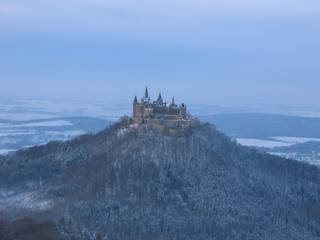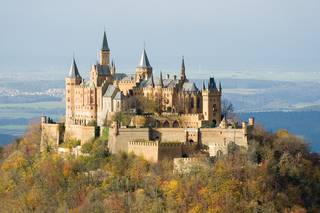
The Swabian Mountains is in a low mountain range in Baden-Württemberg.
Much of the Swabian Mountains consists of gentle to moderate hills often covered with forest or cleared for small-scale agriculture. It occupies the region bounded by the Danube in the southeast and the upper Neckar in the northwest. In the southwest it rises to the higher mountains of the Black Forest. The Swabian Mountains are also known as Swabian Jura or Swabian Alb.

- Bopfingen On the plateau -
- Münsingen - heart of the UNESCO Biosphere Reserve
- Heidenheim - north-eastern border
- Sigmaringen - renowned for its castle above the green Danube valley
- Bad Urach - a climatic health-resort with a thermal bath in impressive landscape
- Hechingen - at the north-western escarpment close to the stunning Hohenzollern Castle
- Reutlingen - called "The gate to the Swabian Mountains"
- Rottweil - is the oldest town in Baden-Württemberg famous for its colorful carneval festival
- Tuttlingen
- Tübingen - a beautiful university town with crooked half-timbered houses in a charming historical city centre
- Ulm - with the highest church spire in the world
- Hohenzollern Castle. A fairytale castle dramatically set on top of a conical hill.
- Lichtenstein Castle. Its a historicist castle built in the 19th century at the edge of the Swabian Alps near Reutlingen.
- UNESCO Biosphere Reserve Swabian Alb. Founded in 2009 out of a former area for military purposes with different geological conditions, different biogeographical regions and the activity of humans.
- Bärenhöhle. It is one of the most visited dripstone caves in Germany, named after the many bear skeletons inside. It was discovered in 1834 by the school teacher Fauth, while he was looking for herbs. A recreational park above the cave makes it a popular trip target on weekends.
- Schönbuch Nature Park. is ideal for hiking, walking and cycling and attracts people seeking rest and relaxation from far and near. With its dense forests, moorland areas and natural stream the Schönbuch became Baden-Württemberg's first nature reserve in 1972.
Locals in the areas speak the distinct German dialect known as Swabian German which varies even throughout the area. The dialect at the top of the plateau is stronger than the broadest Swabian of the lowland areas. Across the whole Swabian region, many phrases and grammar are highly localized, even down to the village level.
